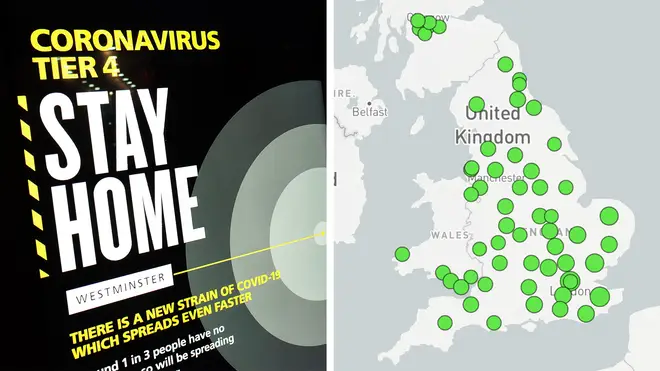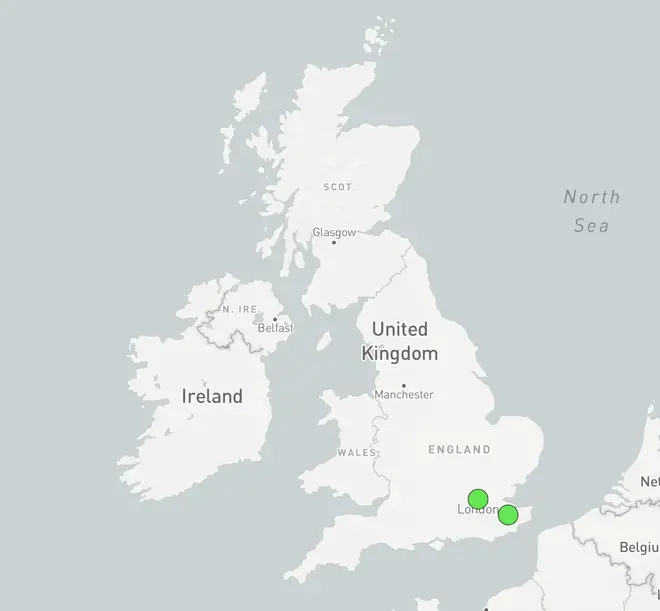
Vanessa Feltz 3pm - 6pm
22 December 2020, 20:32 | Updated: 22 December 2020, 20:34

On Monday, the government’s chief scientific advisor warned that the new Covid strain was “everywhere” in the UK and new data confirms it has spread widely across the country.
Data from the Covid-19 Genomics UK Consortium (COG-UK) has now revealed the extent of the spread, despite Tier 4 measures aimed at tackling this.
The new Covid-19 variant has been found in at least 57 different locations across the UK.
Scientists are using genome sequencing to detect the virus in a sample of positive Covid-19 tests.
The B.1.1.7 strain, also known as VUI-202012/01, has now been detected in samples taken at 45 places in England, six in Scotland and six in Wales.
However, this is not evenly spread across the UK. The cases are clustered in the south of England, with 1,178 samples of the mutant strain found in London.
Read more: Multiple London hospitals suspend non-urgent operations due to Covid-19 pressures
Read more: PM says more than 500,000 people in the UK have had first dose of Covid-19 vaccine

Sage member tells LBC infections need to be brought under control
Samples of the new variant have also been found in Manchester, Liverpool, Birmingham and Newcastle.
The data is also likely to be an understatement, with only a small sample of positive tests being sequenced by the scientists.
At a press conference on Saturday, Chief Scientific Advisor Sir Patrick Vallance said for the week ending 9 December, 62 percent of cases in London involved the new variant.
Read more: Public health chiefs urge Tier 4 visitors to self-isolate - even on Christmas Day

Health experts currently believe the new variant of Covid mutated inside an immunosuppressed patient over a prolonged period of time.
Scientists have gone back over their samples and found that the new variant was first present in two samples that had been collected in Kent and London on September 20 and 21.
However, it was not until mid December that the alarm was raised over the infectiousness of the virus.
Over the last 21 days 31 percent of samples sequenced by COG-UK involved the new strain.
Read more: New coronavirus variant 'could infect children more easily'
See the most recent @CovidGenomicsUK SARS-CoV-2 sequence data visualised in @MyMicroreact https://t.co/AywK4Can02
— Centre for Genomic Pathogen Surveillance (@TheCGPS) December 22, 2020
Filtered to show only the B.1.1.7 lineage. Map circle size is approx proportional to num of samples. 1210/3906 (31%) of samples sequenced in last 21 days are B.1.1.7 pic.twitter.com/RkNcMvQvBU
Although the new variant is spreading faster, and therefore harder to control, there is currently no suggestion that it is more deadly or causes more severe symptoms.
There have also already been various mutations of Covid-19 that have enter communities with no real consequence.
The New and Emerging Respiratory Virus Threats Advisory Group (Nervtag) met again on Monday to consider the new variant and said, while it does not appear to alter the course of the disease, it does spread more easily.
Sir Patrick confirmed this, saying the variant had a "significant substantial increase in transmissibility".
Read more: Covid-19 variant: EU calls for blanket UK travel bans to be lifted
Read more: Stormont advises against all non-essential travel between Northern Ireland and Great Britain
New strains are not always necessarily a bad thing and it could even be less virulent, but if it spreads quicker and has the same severity then more people will become ill in a shorter period of time.
On Tuesday, the UK reported its biggest daily rise since mass testing began, with 36,804 positive Covid-19 cases recorded.
1,875 people were admitted to hospitals across the UK with coronavirus on Friday. This was a decrease from Thursday's 2,095, but is the highest number admitted on a Friday since 17 April.
- A cluster of six in Glasgow and in the surrounding areas of Linwood, Newton Mearns, Airdrie, Bonhill and Lenzie.
- Near Rothbury in rural Northumberland
- In Newcastle-upon-Tyne and in Gateshead, near Low Fell.
- Bishop Auckland in County Durham
- Near Penrith in Cumbria
- Middlesbrough
- Hurst Green in Lancashire
- Cleckheaton
- In Pocklington, near Hull
- Two areas in the north of Merseyside, near Crosby and Kirkby
- One area of central Manchester
- Near Maltby in South Yorkshire
- One area in Wrexham and one in Burton, Cheshire
- Near Matlock in Staffordshire
- Near Eakring in Nottinghamshire
- Woodhall Spa in Lincolnshire
- Near Stafford in Staffordshire
- In the Leicester area
- Upper Hambleton, near Oakham
- Dereham near Norwich
- Stowmarket near Ipswich
- Near Willingham in Cambridgeshire
- Kettering
- Kenilworth near Coventry
- Near the Oldbury area of Birmingham
- Worcester
- Hereford
- In Fishguard, Neath, Bridgend, Barry and Newport
- Bristol
- Near Bridgwater and near Exeter
- Close to Dorchester on the south coast
- Newbury near Thatcham
- New Alresford, near Winchester
- Near Billingshurst
- Dorking
- Near Hailsham
- Near Canterbury
- London
- Near Oxford
- Welwyn Garden City near St Albans
- Braintree
- Stagsden near Bedford